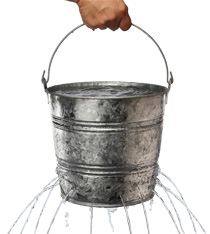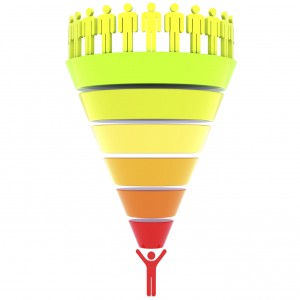Most businesses hoping to improve sales look back to square one: if marketing would only generate more leads, they say, our sales numbers would soar! While that might be true across the board, increasing lead generation isn't the only way to improve your bottom line. After all, it's just the very tip of the iceberg. It can be expensive and time consuming to crank up lead generation through marketing.

The good news is that there’s another way. Tightening up your eCommerce sales funnel is an efficient and low-cost way to improve sales totals. We call it a sales funnel, of course, but for many businesses it can be more like a sieve, leaking perfectly good leads out at every step from start to finish. Some of those lost leads might return soon, but many won't; at best you'll have to start back at the beginning and recruit them all over again, and at worst you'll never see them on your site again. Invest some time in fine-tuning your sales funnel, and you’ll see more leads making it through to the final step.
1. Analyze Your Funnel
The first step in optimizing your sales funnel is really diving deep into your website’s analytics. If you can crunch the numbers and pick out a few "choke points" – the places where leads are abandoning the process – then you can focus your problem-solving efforts on those places. Unless your website and your funnel are a total mess, it's unlikely that you need to overhaul the whole thing. It's more probable that a few small steps are losing you a lot of leads, and that tweaking those areas will smooth out your whole sales funnel, so more make it through and convert.
Related Class: Mastering the Facebook Sales Funnel
Are leads bouncing off your site when they see a certain form? Or abandoning carts when they get to the shipping details page? Or do they not even get past your cluttered shop front of a homepage? Pay attention to the different behaviors of leads arriving at your site from different points of entry; it could be that your email offers are drawing in leads who bail when they get to your vague landing page, or when they read the fine print at the bottom of that landing page. Perhaps your leads arriving from social media abandon your offer when they realize how long the form is or see that their details aren’t auto-filled in the address section.
2. A/B Test Everything – Yes, Everything
You might think that the location of a ‘Next’ button and the font size of a CTA are minor details. Actually, you’re probably right about that. But that doesn’t mean those minor details don’t add up to a layout, or appearance, or functionality, that could be losing you leads. I’ve written about the importance of A/B testing here before; it helps us as marketers move away from hunch-based decision making, so we can base our design and functionality choices on data about what is really the most effective. Try different landing page layouts, different copy, different forms, different page flow, even different colors.
One of the most important things to test in-depth is any form that your leads need to fill out to convert. Of course, forms are necessary in any process, so you can get the details you need to complete the transaction. But it’s important to think hard about what you absolutely need versus what you want. Of course, you’d like to have a little background info on your leads, but if asking them for more details makes them balk, it’s not worth it. Use A/B testing to pinpoint what fields in your form are asking too much, or at what point your forms become too long for leads to bother with. I’d also recommend experimenting with which fields are required to continue and which are optional.
3. Streamline for Mobile Users
It’s a safe bet that a ton of your leads are accessing your site from a mobile device – are you meeting them halfway with a mobile-friendly sales funnel? Whether your leads are coming to you via email, social media, or search results, they will be expecting a site that makes sense and works well on any type of device. Hopefully you’ve already perfected a mobile-specific version of your site, or created your site with responsive design in mind, so that leads on mobile devices don’t struggle with viewing pages, their cart, or necessary forms. That’s definitely the bare-minimum.
Related Class: Developing Content for Every Stage in the Buying Cycle
To really fine-tune your mobile sales funnel, so leads arrive and stay through to completion, you might need to adjust the order of pages, reduce your forms to be shorter and easier, and in general reduce the number of pages necessary to get from A to B. Keep images to a minimum and definitely, definitely avoid anything that requires Flash! Use A/B testing to figure out which mobile tweaks are helping you keep leads.

Adjusting your sales funnel to smooth the path from brand new lead to paying customer is a process that takes time and an eye for detail, but it’s worth it. Don’t waste valuable leads that marketing worked hard to bring in – make it easy and natural for those interested users to move through your process, and they’ll reward you with a boost to your bottom line.